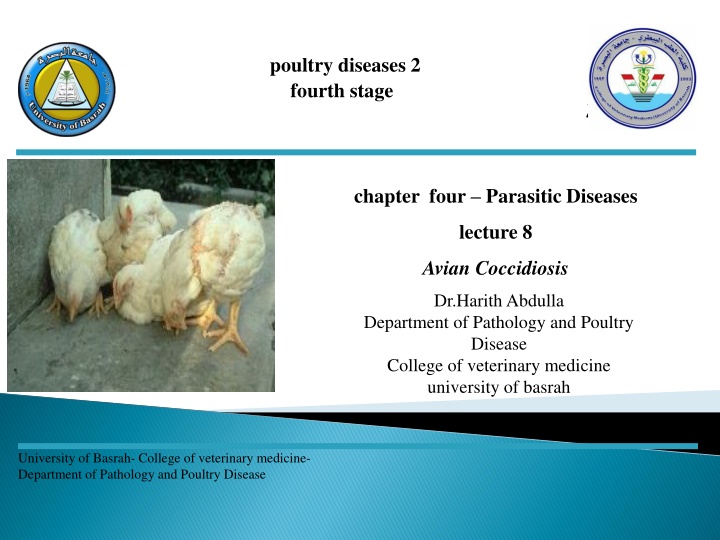
Avian Coccidiosis: Causes, Symptoms, and Management in Poultry
Explore the impact of Avian Coccidiosis on poultry health, including symptoms, diagnosis, and treatment options for this parasitic disease. Learn about the specific species affecting chickens and turkeys, post-mortem lesions, and the conditions required for the maturation of oocysts. Delve into the expertise shared by Dr. Harith Abdulla from the Department of Pathology and Poultry Disease at the University of Basrah, College of Veterinary Medicine.
Download Presentation

Please find below an Image/Link to download the presentation.
The content on the website is provided AS IS for your information and personal use only. It may not be sold, licensed, or shared on other websites without obtaining consent from the author. If you encounter any issues during the download, it is possible that the publisher has removed the file from their server.
You are allowed to download the files provided on this website for personal or commercial use, subject to the condition that they are used lawfully. All files are the property of their respective owners.
The content on the website is provided AS IS for your information and personal use only. It may not be sold, licensed, or shared on other websites without obtaining consent from the author.
E N D
Presentation Transcript
poultry diseases 2 fourth stage chapter four Parasitic Diseases lecture 8 Avian Coccidiosis Dr.Harith Abdulla Department of Pathology and Poultry Disease College of veterinary medicine university of basrah University of Basrah- College of veterinary medicine- Department of Pathology and Poultry Disease
Acute gut infection in chickens and turkeys. All avian species are affected. Host specific. Etiology : Genus Poultry raised on the floor are highly susceptible than those raised on wire floor. Mature Oocyst is the infective stage of the parasite. Oocysts are resistant to the environmental conditions. Etiology : Protozoa. Genus : Eimeria .
1-Mortality. 2-Retarded growth. 3-Cost of drug. Conditions needed for maturation of 1-Temperature ( 28 C ) . 2-Moisture ( High humidity ). 3-Oxygen( O ) . Conditions needed for maturation of oocyst oocyst. .
Species affecting chickens Post Species affecting chickens Post- -mortem lesions mortem lesions 1-Eimeria necatrix a a- -Ballooning in mid gut. b b- -White spots and petechial hemorrhages ( salt and and pepper appearance on serosal surface. c c- -Gut filled with mucoid bloody exudates. d d- -Sausage-like intestine. e e- - Severe necrosis.
2-Eimeria tenella a a- - Erosion of cecal wall ( Cecal Coccidiosis) b b- - Free blood and bloody cores in ceca c c- - Caseous cores in old cases. d d- - Petechiae. e e- - Thickening and ecchymoses. 3- Eimeria brunetti a a- - Infection in lower small intestine (Ileorectal coccidiosis) and rectum. b b- -White area with thickening of lower small intestine and rectal walls. c c- -Coagulative necrosis and mucoid bloody enteritis in the lower gut . d d- -Petechiae. e e- - Severe necrosis.
4-Eimeria maxima a- Faint hemorrhage and wall ballooning. b-Blood tinged mucous or orange exudates. c-Petechiae and thickening of middle third of intestine. d- Mild to severe enteritis. 5-Eimeria acervulina a- Ladder like -lesions produced by white plaques oocyst in the duodenum. b- Thickening and petechiae.
6-Eimeria mivati a- Occurs in epithelium of the upper gut (duodenum). b- Lesions similar to Eimeria acervulina . 7-Eimeria mitis a- Occurs in upper third of small intestine. b- Difficult to see any lesion. c- Slight mucoid appearance. 8-Eimeria praecox a- Causing diarrhea. b-Excess liquid and mucus in duodenal loop. 9-Eimeria hagani =
1-Clinical signs. a-Diarrhea. b-Sudden death of well fleshed birds. c-Blood-stained feces ( bleeding). 2-Post-mortem changes. 3-Examination of fecal sample with light microscope for detection of oocysts. 4- Histopathology.
1-Amprolium : Is drug of choice, used in water. 2-Sulfa drugs. Prevention: 1-Chemotherapy :Coccidiostats :Most particle and used with feed. 2-Vaccination. Prevention:
